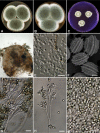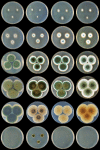Sex in Penicillium series Roqueforti
- PMID: 22679577
- PMCID: PMC3348777
- DOI: 10.5598/imafungus.2010.01.02.10
Sex in Penicillium series Roqueforti
Abstract
Various fungi were isolated during the course of a survey in a cold-store of apples in the Netherlands. One of these fungi belongs to the genus Penicillium and produces cleistothecia at 9 and 15 °C. A detailed study using a combination of phenotypic characters, sequences and extrolite patterns showed that these isolates belong to a new species within the series Roqueforti. The formation of cleistothecia at low temperatures and the inability to produce roquefortine C, together with a unique phylogenetic placement, make these isolates a novel entity in the Roqueforti series. The name Penicillium psychrosexualis sp. nov. (CBS 128137(T)) is proposed here for these isolates.
Keywords: P. carneum; P. paneum; Penicillium; phylogeny; roqueforti; taxonomy.
Figures






Similar articles
-
Reclassification of the Penicillium roqueforti group into three species on the basis of molecular genetic and biochemical profiles.Microbiology (Reading). 1996 Mar;142 ( Pt 3):541-549. doi: 10.1099/13500872-142-3-541. Microbiology (Reading). 1996. PMID: 8868429
-
Molecular identification of species from the Penicillium roqueforti group associated with spoiled animal feed.Appl Environ Microbiol. 2000 Apr;66(4):1523-6. doi: 10.1128/AEM.66.4.1523-1526.2000. Appl Environ Microbiol. 2000. PMID: 10742236 Free PMC article.
-
Morphological and molecular characterisation of Penicillium roqueforti and P. paneum isolated from baled grass silage.Mycol Res. 2008 Aug;112(Pt 8):921-32. doi: 10.1016/j.mycres.2008.01.023. Epub 2008 Jun 13. Mycol Res. 2008. PMID: 18554890
-
Evolutionary formation of gene clusters by reorganization: the meleagrin/roquefortine paradigm in different fungi.Appl Microbiol Biotechnol. 2016 Feb;100(4):1579-1587. doi: 10.1007/s00253-015-7192-y. Epub 2015 Dec 15. Appl Microbiol Biotechnol. 2016. PMID: 26668029 Review.
-
Biosynthetic gene clusters for relevant secondary metabolites produced by Penicillium roqueforti in blue cheeses.Appl Microbiol Biotechnol. 2016 Oct;100(19):8303-13. doi: 10.1007/s00253-016-7788-x. Epub 2016 Aug 23. Appl Microbiol Biotechnol. 2016. PMID: 27554495 Review.
Cited by
-
Characterization and phylogeny of fungi isolated from industrial wastewater using multiple genes.Sci Rep. 2022 Feb 8;12(1):2094. doi: 10.1038/s41598-022-05820-9. Sci Rep. 2022. PMID: 35136108 Free PMC article.
-
Phylogeny of Penicillium and the segregation of Trichocomaceae into three families.Stud Mycol. 2011 Nov 15;70(1):1-51. doi: 10.3114/sim.2011.70.01. Stud Mycol. 2011. PMID: 22308045 Free PMC article.
-
Diversity of yeast and mold species from a variety of cheese types.Curr Microbiol. 2015 Jun;70(6):792-800. doi: 10.1007/s00284-015-0790-1. Epub 2015 Feb 19. Curr Microbiol. 2015. PMID: 25694357
-
Penicillium polonicum-mediated green synthesis of silver nanoparticles: Unveiling antimicrobial and seed germination advancements.Heliyon. 2024 Apr 4;10(7):e28971. doi: 10.1016/j.heliyon.2024.e28971. eCollection 2024 Apr 15. Heliyon. 2024. PMID: 38601517 Free PMC article.
-
Sex in cheese: evidence for sexuality in the fungus Penicillium roqueforti.PLoS One. 2012;7(11):e49665. doi: 10.1371/journal.pone.0049665. Epub 2012 Nov 21. PLoS One. 2012. PMID: 23185400 Free PMC article.
References
-
- An K-D, Kiyuna T, Kigawa R, Sano C, Miura S, Sygiyama J. (2009) The identity of Penicillium sp. 1, a major contaminant of the stone chambers in the Takamatsuzuka and Kitora Tumuli in Japan, is Penicillium paneum. Antonie van Leeuwenhoek 96: 579–592 - PubMed
-
- Boysen M, Skouboe P, Frisvad J, Rossen L. (1996) Reclassification of the Penicillium roqueforti group into three species on the basis of molecular genetic and biochemical profiles. Microbiology 142: 541–549 - PubMed
-
- Eagle CE. (2009) Mating-type genes and sexual potential in the Ascomycete genera Aspergillus and Penicillium. PhD thesis, University of Nottingham;
-
- Felsenstein J. (1985) Confidence limits on phylogenies: An approach using the bootstrap. Evolution 39: 783–791 - PubMed
-
- Frisvad JC, Filtenborg O. (1989) Terverticillate penicillia: chemotaxonomy and mycotoxin production. Mycologia 81: 837–861
LinkOut - more resources
Full Text Sources
